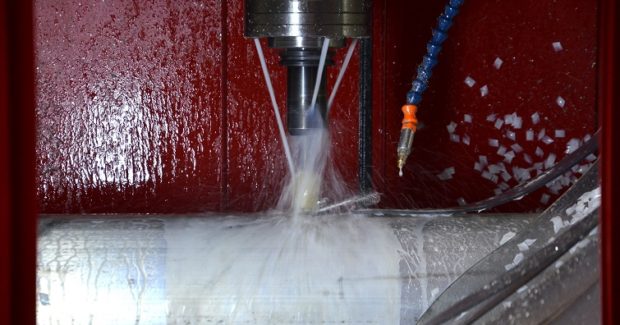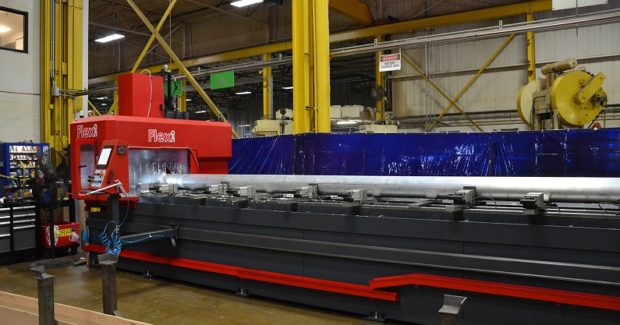There’s No Place Like Home
Without a means to accomplish certain in-house machining easily and consistently, this handrail manufacturer was sending out a huge chunk of work – leaving their commitment to ship dates, lead times, costs and overall project control out of their control. A trip to FABTECH changed all that.
Posted: September 3, 2019
Architectural handrail is an important and growing segment of the Wagner product line manufactured by R&B Wagner Inc. (Milwaukee, WI), an industry leader in state-of-the-art, easy to install, attractive and functional architectural glass handrail and railing systems, as well as contemporary and traditional handrail systems for interior and exterior installations. In addition to standard-sized components, they customize handrails for length, mounting hole spacing and more. A vital component of the installation process is an aluminum “shoe” that requires 5/8 in thru-holes with 1-1/8 in countersink every foot along the 20 ft section of aluminum channel. The channel is approximately 2 in wide by 4 in high with a wall thickness of .675 in. Without a means to accomplish this process in-house easily and consistently, the shop farmed this work out for every 10 ft and 20 ft section of their standard product line. Since about 90 percent of their work is standard, a huge chunk of work was being sent out – leaving their commitment to ship dates, lead times, costs and overall project control out of their control.
A short drive from their Milwaukee plant to the FABTECH trade show changed all of that. While walking the show floor, Kane Behling, the director of operations at Wagner, and Bill Paquin, their chief financial officer, saw an open bed vertical machining center from FlexCNC (Wapakoneta, OH) that showed promise. Behling soon scheduled a visit to Wapakoneta to see the FlexCNC factory and take a closer look at this interesting technology. While he and Mike Skelton, their manager of manufacturing engineering, were on site, FlexCNC president Nick Kennedy and his team walked them through the set-up and operation of a machine and proved out the concept by running their parts. “We were impressed by how engaged they were in the process,” said Skelton. “They really took the time to understand what we wanted to do, and then proved to us that it could be done with this machine.”
After the meeting, they purchased a model TRD25-02 open-bed vertical machining center that allowed them to bring the machining of their 10 ft and 20 ft glass panel mounting channel in-house, shaving a couple weeks off lead times, reducing inventory, saving money and providing them with more control of their manufacturing process. Skelton estimates that bringing a single product in-house – the aluminum shoe with 5/8 in thru-holes every foot – will allow a three-year payback on the $250,000 machine, which is currently busy drilling holes in their 10 ft and 20 ft sections of aluminum for their standard product, as well as custom projects that require variations in hole size or spacing. That’s not all: Skelton has plans to machine additional products on the vertical machining center, shortening the payback even more.
The TRD25-02 VMC features an open bed for easy loading, machining, and unloading of long or large parts. Its modular design allows beds from 10 ft to 80 ft long, so Skelton and his team opted for a 25 ft bed to efficiently handle their 20 ft lengths. “We process 20 ft long product, but we wanted the 25 ft length so that we could put the 4th axis on and not have to take it off every time,” noted Skelton. While he is focusing on machining a single product that does not require the 4th axis, Skelton points out that “we have some applications where we intend to use it, but we just haven’t gotten there yet.” Bringing the machining of standard aluminum sections in-house has shaved costs as well as time from their manufacturing process. Lead times for in-house manufactured product have decreased by about two weeks since the TRD25-02 VMC came online.
Similarly, the ten percent of product mix that requires variations in hole size or spacing has also benefited – maybe even more so – because these specials were previously machined in-house on equipment that was poorly suited for the task. “We didn’t have anything that could machine a 20 ft section,” recalled Skelton, “so we’d fixture it into a vertical machining center, drill it, remove it, turn it around, re-fixture and drill the other end.” Since these projects were custom and not likely to be repeated, the time required to complete the manual tasks involved was never studied. Skelton did, however, report “significant time savings” using the FlexCNC. In addition to being able to machine a 20 ft section of aluminum rail shoe in a single set-up, the programming is greatly simplified. “Our operators can accomplish this through the conversational programming,” stated Jeremy Neerhof, a manufacturing engineer. “This is very beneficial for us because we don’t have to spend time programming and transferring files to the TRD25-02.”
When machining 10 ft sections, the shop cuts production time and enhances efficiency by working in the FlexCNC’s pendulum mode. With a light curtain for safety, this feature allows operators to load or unload parts for a production run while the machine is operating on another batch. “That’s another reason that we opted for a 25 ft machine,” said Skelton. “We can use the pendulum mode on 10 ft sections and not lose any production time.” He also has plans for running the TRD25-02 in pendulum mode for smaller parts: railing posts, components, etc., as well as components for the contract metal manufacturing side of the business. But for now, the machine is busy drilling and finishing holes on standard and custom sections of aluminum, reducing downtime and inventory, and returning control of the manufacturing process along the way.
R&B Wagner Inc., 10600 West Brown Deer Road, Milwaukee, WI 53224, 414-214-0444, www.wagnercompanies.com.
FlexCNC, 851 Industrial Drive, Wapakoneta, OH 45895-9239, 800-837-2503, [email protected], www.flexmachinetools.com.


















